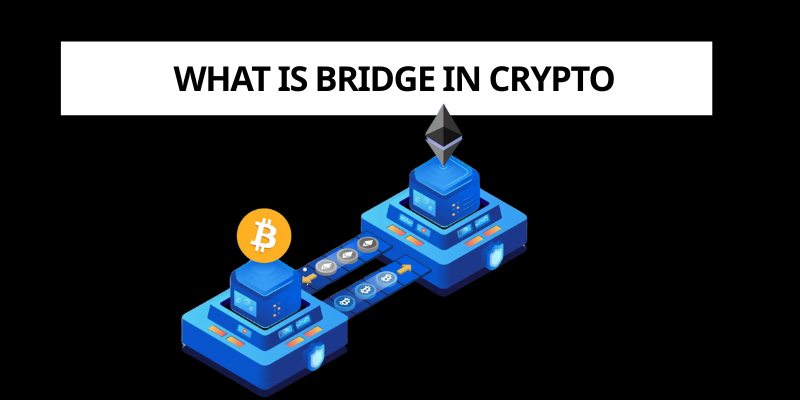What Is Bridge in Crypto? The Key to a Connected Blockchain Ecosystem
As the cryptocurrency ecosystem grows, the question what is bridge in crypto has emerged as a critical inquiry for understanding blockchain interoperability. A crypto bridge is a protocol that connects disparate blockchain networks, enabling the transfer of assets, data, and functionalities across them. In a world where blockchains like Bitcoin, Ethereum, and Solana operate independently, bridges serve as essential infrastructure, fostering collaboration and expanding the utility of decentralized technologies.
Contents
What Is Bridge in Crypto?
So, what is bridge in crypto? At its simplest, a crypto bridge is a technological solution that links two or more blockchains, allowing them to share resources seamlessly. Blockchains are inherently siloed, with unique protocols, token standards, and consensus mechanisms. For example, Bitcoin’s BTC cannot natively interact with Ethereum’s smart contracts. A crypto bridge solves this by facilitating cross-chain transfers, often through wrapped tokens or liquidity pools.
The process typically involves locking or burning tokens on the source blockchain and minting equivalent tokens on the destination chain. For instance, bridging ETH to Polygon creates a wrapped version of ETH compatible with Polygon’s ecosystem. This ensures value preservation while enabling users to leverage the destination chain’s features, such as lower fees or faster transactions.

Categories of Crypto Bridges
To fully grasp what is bridge in crypto, it’s essential to understand the different types of bridges:
Centralized (Trusted) Bridges: Operated by a single entity, like Binance Bridge, these offer speed and affordability but require trust in the operator, posing risks like custodial mismanagement.
Decentralized (Trustless) Bridges: Relying on smart contracts, trustless bridges, such as Celer Bridge, prioritize decentralization but face challenges like higher fees and smart contract vulnerabilities.
Unidirectional and Bidirectional Bridges: Unidirectional bridges, like Wrapped Bitcoin, support one-way transfers, while bidirectional bridges, such as Wormhole, allow two-way movement.
Programmable and Federated Bridges: Programmable bridges enable complex data transfers, while federated bridges, like Wanchain, rely on a group of validators for security.
Each type caters to specific needs, from cost-conscious users to those prioritizing decentralization.
Why Crypto Bridges Matter
Crypto bridges are pivotal for several reasons, answering what is bridge in crypto with practical benefits:
- Bridges enable blockchains to work together, allowing users to move assets like USDT from Ethereum to Solana for DeFi activities.
- Bridging to layer-2 networks like Arbitrum or Polygon reduces transaction costs compared to Ethereum’s high gas fees.
- Users can explore dApps on multiple chains, such as Solana’s Jupiter or Polygon’s Aave, without selling their assets.
- Bridges empower developers to create cross-chain applications, combining the strengths of different networks.
These advantages make bridges indispensable for scaling Web3 adoption.
Challenges and Risks
Understanding what is bridge in crypto also requires acknowledging the risks:
- Bridges are lucrative targets for hackers. The 2022 Ronin bridge hack ($600 million) and Wormhole exploit ($325 million) highlight vulnerabilities in smart contracts and custodial systems.
- Trusted bridges risk censorship or fund theft by the operator, undermining decentralization principles.
- Cross-chain transfers create intricate trails, complicating monitoring and increasing risks of fraud.
- As bridges handle significant value, they face scrutiny from regulators, necessitating compliance with global standards.
Users should prioritize bridges with robust audits and transparent operations, starting with small test transactions.

The Road Ahead for Crypto Bridges
In 2025, the question what is bridge in crypto is gaining new dimensions as bridges evolve. Multi-chain bridges, connecting multiple networks, are emerging to create a more cohesive ecosystem. Innovations like Phantom’s Cross-Chain Swapper simplify user experiences, offering “Best Return” or “Fastest” options for bridging. Security is improving through advanced audits and trustless designs, addressing past exploits.
The growing popularity of layer-2 solutions and alternative layer-1 chains, like Solana and Avalanche, underscores the demand for efficient bridges. Projects like Polkadot and Interlay are developing trustless bridges to enhance cross-chain connectivity, promising a future where interoperability is seamless.
The question what is bridge in crypto unveils a critical component of the blockchain ecosystem. Crypto bridges enable interoperability, connecting siloed networks to facilitate asset transfers, reduce costs, and drive innovation. Despite challenges like security risks and regulatory hurdles, ongoing advancements are strengthening their reliability and accessibility.
For users and developers, understanding what is bridge in crypto is essential for unlocking the full potential of decentralized finance and Web3, paving the way for a connected, inclusive blockchain future.